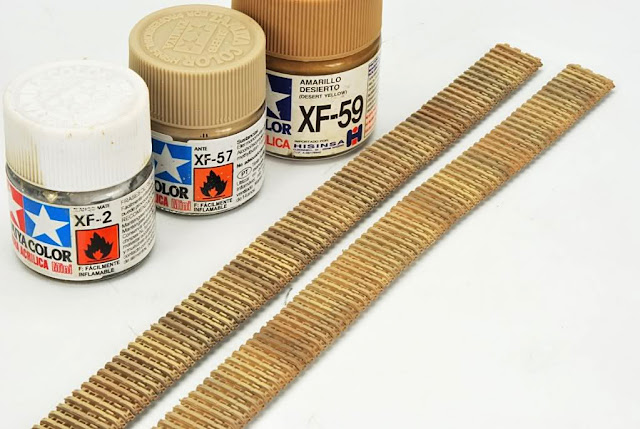Another daring step where faith is necessary! There´re a lot of ways for simulating mud: with plaster, with acrylic resin and pigments, with specific products so on. All methods are good ways to achieve an attractive result with the mud, depending on modellers taste or affinity with the materials involved. My favourite: Tamiya´s texture paint. Why? A big bottle can mix it with sand, pigments or acrylic paint and, most of all, fix strongly with any kind of surface:
Adding some dark brown pigment and paint to the Tamiya´s paint, I achieve approximately a nice colour to start adding the mud. Anyway, the colour is NOT important. Just the texture IS important. Must be in scale and as heterogeneous as possible:
Using a bush, I applied the mix to my taste to the wheels and the lower part of the tank. As can be seen in the pictures, the result is anything but nice! But keep the faith! This is just the beginning!:
Once the texture paint is dry (a day or more, do not be impatient), using a colour mix of paints similar to the AK´s dust used previously, I randomly applied a fine coat of dust over the wheels. Be sure that this paint don´t hide all the elements or you´ll achieve a dull and unattractive surface. As usually, do it as heterogeneous as possible:
Remember that this paint can´t be removed, so be carefully when applying the paint with your airbrush:
And, why not, let´s start with the tracks. Use ALWAYS the same colours for dust in all the parts of the vehicle. Of course you can play a little bit with the mix proportions, but do not use different colours to simulate the same effect: dust and dirt:
Now, the final steps for the mud are a mix of techniques and products that I´ll try to resume at my best:
- Using oils: Naples Yellow, Natural Umber and Black, I made 3 mixes of these colours (like I did with acrylics) and using them as a wash, I applied them randomly on the different wheels with different intensities.
- For splashes, I used acrylic paints slightly diluted projected to the wheels with the help of an old airbrush
- Just in the tracks (where the two previous steps were also applied), I added punctually some pigments (a mix of three colours from Iraqi Sand and Russian earth ) to achieve some textures here and there. Remember that if you use a lot of pigments, you´ll spoil all the previous work as the surfaces where the pigments are used, if you´re not careful, will get dull, bored and will hide all the previous work!:
And then ..... finally, at last .... miracle!!! ........... just painting the tools, towing cables ... et voilá!
Many thanks for your attention!



















Muchas Gracias por compartir este magnifico tuto. Esperamos impacientemente el proximo. Un Abrazo
ReplyDeleteAmazing. Thank you for sharing. I'm waiting for antorher model.
ReplyDeleteThanks for this work!
ReplyDeletevery very nice!! thank you for sharing
ReplyDeleteAmazing job!!!
ReplyDeleteJust...perfect!
ReplyDeleteInspiring modeling work.
tu tecnica es muuuuy inspiradora, gracias por compartir
ReplyDeleteA great and complete tutorial - thank you.
ReplyDeleteTony
A great and complete tutorial
ReplyDeleteThe best and most Impressive 1/48 Tiger I have seen so far!!
ReplyDeleteThis is one of the nicest tutorials I've seen. Very detailed steps and good pictures of the intermediate results. Will use this as an guide for my Tamiya 1/35 scale Tiger I.
ReplyDeleteThanx.